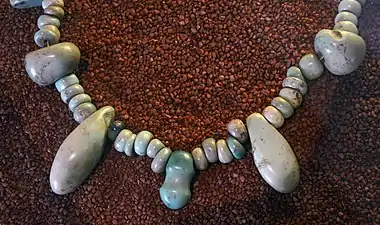
An example of a variscite "callaïs" necklace of Neolithic origin, dated 4500 - 4000 BC, found in Arzon. The necklace now located in the Musée d'Histoire et d'Archéologie de Vannes.
Callaïs is the generic name for ancient green-blue precious stones used for making pendants and beads by western European cultures of the later Neolithic and early Bronze Age. The term includes turquoise and variscite but not jade.[1][2][3] "Callaïs" was described by Pliny the Elder as being paler than lapis lazuli.[4] Callaïs objects have been found in Neolithic tombs from the mid-5th millennium BC in the Carnac region of western France.[2][1]
Callaïs deposits are thought to have been widely distributed throughout the Iberian peninsula, and transported from Andalusia, Castile, and Catalonia to Brittany, Normandy, and the Paris Basin.[2]
References
- 1 2 La parure en callaïs du néolithique européen. G. Querré, Serge Cassen, Emmanuel Vigier. Oxford. 2019. pp. 85, 423. ISBN 978-1-78969-281-5. OCLC 1128026690.
{{cite book}}: CS1 maint: location missing publisher (link) CS1 maint: others (link) - 1 2 3 Cassen, Serge; Petrequin, Pierre; Guirec, Querre; Grimaud, Valentin; Rodriguez-Rellan, Carlos (2019). "Spaces and signs for the transfer of jade and callaïs in the Neolithic of Western Europe". A taste for green : a global perspective on ancient jade, turquoise and variscite exchange. Carlos Rodríguez-Rellán, Ben A. Nelson, Ramón Fábregas Valcarce. Oxford. pp. 122–132. ISBN 978-1-78925-277-4. OCLC 1129585280.
{{cite book}}: CS1 maint: location missing publisher (link) - ↑ Rodriguez-Rellan, Carlos; Fábregas Valcarce, Ramón; Faustino Carvalho, António (2019). "From the green belt: an appraisal on the circulation of Western Iberian variscite". A Taste for Green: A global perspective on ancient jade, turquoise and variscite exchange. Carlos Rodríguez-Rellán, Ben A. Nelson, and Ramón Fábregas Valcarce. Oxford, England: Oxbow Books. pp. 77–96. ISBN 978-1-78925-277-4. OCLC 1129585280.
- ↑ Pliny the Elder. Naturalis Historia, liber xxxvii. pp. lvi 151.
This article is issued from Wikipedia. The text is licensed under Creative Commons - Attribution - Sharealike. Additional terms may apply for the media files.